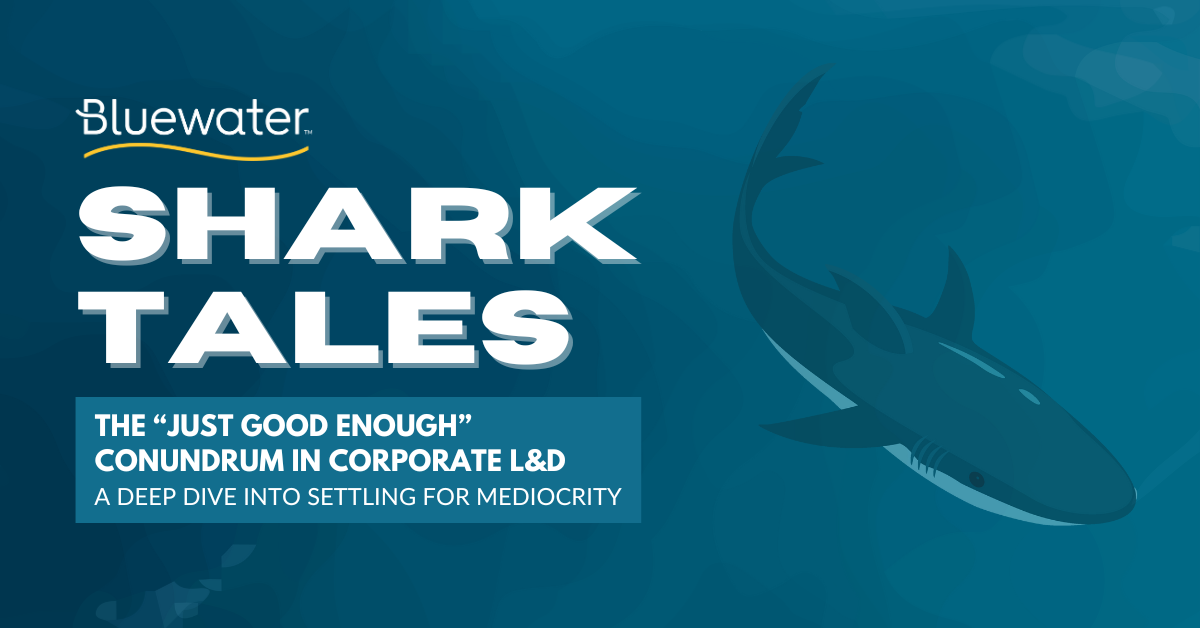The Just Good Enough Conundrum in Corporate L&D: A Deep Dive into Settling for Mediocrity
by Chris Bond | January 18, 2024 10:30 AM |

In the current corporate arena, where adaptability and continuous upskilling are the linchpins of survival, the importance of robust Learning and Development (L&D) strategies cannot be overstated. Companies are progressively recognizing this and channeling resources into their L&D departments with the hope of forging a workforce capable of navigating the turbulent waters of today’s market. However, a concerning trend has emerged within many organizations—an inclination towards accepting "just good enough" in the realm of corporate learning. This raises a crucial question: Why is there a hesitation to pursue excellence? In this piece, we scrutinize the myriad factors that precipitate this acceptance of mediocrity and the significant implications it harbors for future growth.
Budget Constraints: A Critical Bottleneck
A primary hurdle that L&D departments face is the allocation of funds. Unlike sales or marketing, L&D is often relegated to the backseat in budget meetings, with many businesses perceiving it as a non-revenue-generating expense rather than a fertile ground for future gains. This financial bottleneck forces L&D teams to work within tight constraints, thereby making the pursuit of excellence a secondary priority to finding a viable, cost-effective "good enough" solution.
The Race Against Time: When Quick Fixes Trump Quality
The corporate world is under relentless pressure to deliver instant results, and L&D is no exception. However, the creation of exceptional learning experiences is not something that can be rushed. It demands an investment of time for meticulous research, innovative design, pilot studies, iterative feedback, and final refinements. Given the immediacy of business demands, L&D departments are often compelled to prioritize rapid deployment over meticulous craftsmanship, resulting in solutions that are expedient rather than transformative.
Strategic Disarray: The Directionless Pursuit
An L&D department bereft of a clear and cohesive strategy is akin to a ship navigating without a compass. The absence of strategic clarity can stem from ambiguous corporate objectives, inconsistent leadership, or a frequent shift in organizational direction. This disarray hinders the planning and execution of standout learning programs, leading to an improvised approach where "just good enough" becomes the operational standard. L&D teams are then left to produce ad hoc solutions that, while temporarily filling gaps, do not contribute to sustained progress or innovation.
Vague Success Metrics: The Ambiguity of Achievement
Defining and measuring success in L&D can be elusive. Without concrete metrics that are aligned with the broader goals of the organization, L&D efforts can lack direction and purpose. This vagueness fosters an environment where mediocre outcomes may not be identified or challenged, as there is no benchmark for excellence. The absence of quantifiable success indicators diminishes the drive for continuous improvement, allowing the "just good enough" mindset to prevail by default.
Risk Aversion: The Fear of Charting New Waters
Innovation inherently involves risk, and not all organizations have the appetite for it, especially when the outcomes are uncertain or the return on investment is not immediate. This aversion to risk can lead L&D departments to default to conventional methods and content that, while familiar, may not be the most effective or up-to-date. The reluctance to experiment with novel learning methodologies stifles the potential for breakthroughs in employee development.
Legacy Systems: The Anchors of the Past
Many organizations are weighed down by legacy systems that are deeply embedded into the fabric of their L&D strategies. These systems, often resistant to change due to cost and complexity, act as anchors, holding back the potential for adopting more modern and effective learning solutions. The sheer inertia of these legacy systems can perpetuate a "just good enough" mentality as the effort and investment required to modernize seem daunting.
The Ripple Effect of Complacency
The ramifications of settling for mediocrity in L&D are far-reaching:
- Employee Engagement: Subpar learning experiences fail to engage and inspire employees, leading to disinterest and a lack of motivation.
- Compliance Challenges: Inadequate training can lead to difficulties in meeting regulatory and compliance requirements.
- Talent Drain: High-performing L&D professionals may seek opportunities elsewhere if their skills are not utilized to their full potential.
- Retention Woes: A workforce that does not feel invested in thorough quality training may exhibit higher turnover rates.
- Competitive Stalemate: Organizations that do not evolve their L&D practices may find themselves at a disadvantage compared to more innovative competitors.
- Reskilling Roadblocks: Ineffective training hampers the ability to reskill employees efficiently, a necessity in a rapidly changing job market.
- Resource Strain: Settling for "good enough" can paradoxically require more staff to manage and compensate for the deficiencies in the training programs.
- Training Limitations: There may be a cap on the breadth and depth of training that can be provided, hindering the development of a versatile skill set among employees.
- Cultural Frustration: A pervasive sense of dissatisfaction can emerge if there is a general sentiment that the organization does not excel at nurturing its talent.
Financial Consequences of Complacency
The financial impact of accepting mediocrity in L&D can be subtle yet significant. Organizations may incur higher costs as they scramble to augment inadequate systems with additional solutions. Moreover, studies have started to draw a correlation between the quality and consistency of training and an organization's financial performance, suggesting that "just good enough" can lead to a tangible erosion of revenue.
Navigating Organizational Politics
The influence of financial gatekeepers, often the CFOs, on L&D decisions cannot be overstated. Their perspective on spending can significantly sway the direction and quality of L&D initiatives. If the perceived value and potential return on investment of high-quality L&D are not clearly communicated, the inclination is to default to cost-saving measures. The challenge lies in constructing a compelling business case that resonates with the financial decision-makers, demonstrating that investing in top-tier L&D will yield substantial long-term benefits.
This requires not only a presentation of data and potential outcomes but also an understanding of the leadership's mindset. It demands persuasive skills to shift the perception of L&D from a discretionary expense to a strategic necessity. The task is arduous but essential. A passive approach, one that accepts rejection without contest, is not an option for those who truly understand the transformative power of exceptional L&D.
Summary
In conclusion, the "just good enough" approach in corporate Learning and Development is not just a minor setback; it's a systemic issue that can have wide-ranging negative effects on an organization's growth, innovation, and competitive edge. The factors contributing to this mindset, from budget constraints to risk aversion, are significant yet not insurmountable. It is imperative for L&D leaders and advocates to recognize these challenges and actively work to counter them.
As we continue to explore this topic, it becomes clear that overcoming the "just good enough" conundrum requires a multifaceted strategy. This includes securing adequate funding, defining clear and measurable objectives, embracing a culture of innovation, updating or replacing legacy systems, and most importantly, demonstrating the tangible value of high-quality L&D to those who hold the purse strings.
The journey towards excellence in L&D is not merely about improving training programs; it is about fundamentally transforming the perception of employee development from a discretionary expense to an indispensable investment in the future. By refusing to accept mediocrity and advocating for a culture that values and invests in its people, organizations can not only enhance their L&D outcomes but also foster a more engaged, skilled, and resilient workforce.
As we move forward, let us keep in mind that the quality of an organization’s L&D initiatives is a powerful reflection of its commitment to its employees and its future. It is a commitment that requires vision, dedication, and a steadfast refusal to settle for "just good enough." With the right approach and determination, we can all contribute to elevating corporate learning to new heights of excellence.
Looking Ahead: Strategies for Change
As we look to the future posts, we will explore actionable strategies to counteract the "just good enough" mentality. We will discuss how to articulate the value of L&D initiatives, leverage data to build a persuasive business case, and harness innovative technologies and methodologies to elevate the learning experience. Our journey will involve redefining the metrics of success, fostering a culture of learning that aligns with organizational goals, and ultimately, proving that excellence in L&D is not just a lofty ideal, but a tangible driver of organizational success.
Stay with us as we pave the way off the "just good enough" track and onto the path of excellence, which promises to enrich not just the individual employee but the entire organizational ecosystem.
Search Our Blogs
Categories

